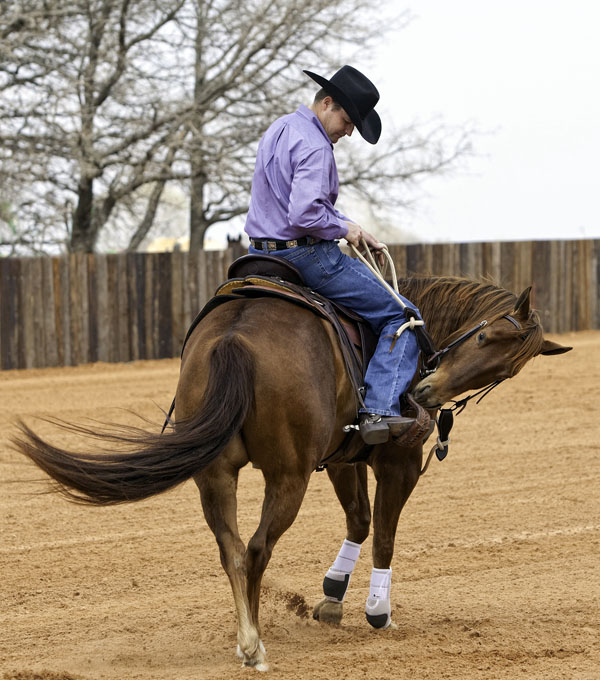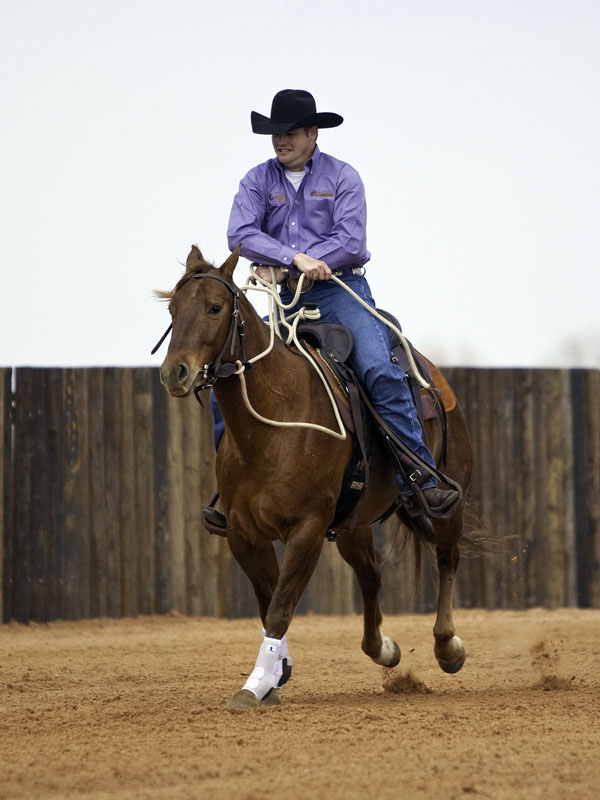“Clinton, my mare sometimes bucks, especially when I ask her to lope. What should I do?”

First, is your horse really bucking? Often, what people call bucking is really just kicking up or “crow-hopping”—the front legs stay on the ground while the horse kicks up his hind legs, which a rider can feel. True bucking, by contrast, is what you see at the rodeo: All four feet are off the ground, the horse’s head is down low, his mouth is open, and he’s bellowing like a cow having trouble giving birth.
The crow-hopping comes from a lack of respect. Often the culprit is a fat, lazy horse that doesn’t want to go forward. When you ask this horse to lope, and he kicks up with his back legs, it’s his way of telling you to get lost.
[LEARN MORE: Get the rest of Clinton Anderson’s Training Methods.]
Clinton Anderson: Lessons Well Learned: Why My Method Words for Any Horse
Training on the Trail: Practical Solutions for Trail Riding
Clinton Anderson Downunder Horsemanship: Gaining Respect and Control on the Ground, Series 1
Clinton Anderson Colt Starting Training Kit
(As an Amazon Associate, we earn from qualifying purchases made through affiliate links.)
By contrast, most horses that are really bucking aren’t showing a lack of respect. They’re most likely reacting to fear: of you being on his back; of the saddle (especially the cinch or back cinch); of your legs or your spurs; or of something jumping out of the bushes in front of him. Something has caused him to use the reactive side of his brain; that’s how most horses learn to buck.
That said, once a horse has dumped a rider three or four times, he might well be bucking out of habit, not fear. At this point, what might’ve started out as a fear issue has turned into a lack-of-respect issue.
THE CROW-HOP CURE: GO FORWARD
If what your horse is doing is crow-hopping, signaling a lack of respect, you need to get his feet moving more willingly. This you can do most safely from the ground.
Put him in a round pen, and get him moving freely at a lope, using my point, cluck, spank sequence. (First, point in the direction you want him to go; then cluck, if necessary, to make him lope; then spank—first the ground, then the horse, if need be. If you don’t have a round pen, do this as part of my longeing for respect; if you don’t know how to do this, access the instructions at HorseandRider.com.)
Get him so hooked onto you that as soon as you point and cluck, he starts loping straightaway. Make his feet hustle—try to get rid of all his laziness and lack of respect on the ground.
Then, when you get on him, give him your ordinary cue when you’re ready to lope. Wait for a count of two, and if he doesn’t go, cluck. Wait again, and if he doesn’t respond, spank him side to side (“over and under”) with the end of your reins or mecate.
If he kicks up, spank him again: whack, whack, with rhythm. Repeat until you get the last word, and your horse realizes that every time his back legs leave the ground, you’re going to whack him (and every time he goes forward obediently, you’ll leave him alone).
If you’re not a confident enough rider to go through this process, do a lot more groundwork to compensate. Then, have a more experienced person ride your horse for a few days to get his feet moving forward at the lope before you try it the first time.
(A caveat: This technique is only for a horse that’s crow-hopping, not bucking like a bronc. If you spank a bronc, you just make him buck harder.)
IF YOU’RE BUCKED OFF
So, what if your horse is genuinely bucking and you come off? You’ve probably heard the saying about getting right back on and showing the bronc who’s boss.
I don’t believe in that. If I get bucked off a colt, the last thing I would do is get straight back on. That’s because if you do, chances are he’s just going to buck you off again—and you’ll only be teaching him how effective bucking is.
Instead, figure out why he’s bucking. Usually, the answer is because you’ve done a poor job of preparation on the ground. As my friend and mentor Gordon McKinlay says, “The more times you pick yourself up off the ground, the better your groundwork gets.”
So, once again, the solution is to take hold of the lead rope or mecate and start moving your horse’s feet—forward, backward, left, and right. Really make his feet hustle, and keep at it until he’s tired and sweaty and using the thinking side of his brain.
Only then get back on and ride him. A lot! Keep hustling his feet from the saddle until you make him regret bucking you off. After that, let him stand tied at the barn for a good while to absorb the session, then ride him again.
Then, to reduce the chance he’ll try to buck again the next time you ride him, make sure to do plenty of extra groundwork before you mount up.
EMERGENCY BRAKE = ONE-REIN STOP
Also pay close attention whenever you ride that horse in the future, and if you feel him even thinking about bucking, do a one-rein stop to prevent it. (The one-rein stop is something you should already have practiced with your horse, as it’s your all-purpose emergency brake.)

To do one, slide your hand down one rein and pull your horse’s head to that side, while using your leg on the same side to push his hind legs so they cross over, disengaging his hindquarters.
As soon as he’s stopped, hop off and go right back to work moving his feet from the ground. (That’s why you should always ride with a mecate or carry a 14-foot lead with you—so that if you need to stop and do groundwork while riding, even out on the trail, you can.)
So your main tool—and the common denominator for both genuine bucking and crow-hopping—is plenty of groundwork. It keeps you safe, solves lack-of-respect issues, and prepares your horse to be good under saddle.
This article is adapted with permission from Lessons Well Learned: Why My Method Works for Any Horse, by Clinton Anderson (downunderhorsemanship.com).

